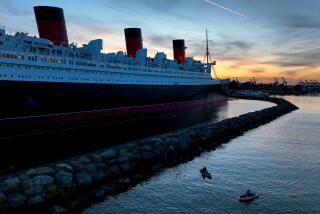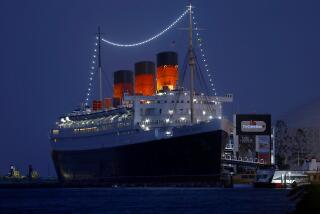How the rise of air travel sparked a new industry: cruise lines
Annie Wichert set sail for the first time in 1946 on a transatlantic voyage aboard the Queen Mary, now a floating hotel in Long Beach. Her next cruise — an Alaskan voyage — was 60 years later.
Things, she found, had changed. A lot.
“My goodness, I got lost so many times,” said Wichert, who lives in the San Fernando Valley. “They had a casino on board. And I won $200.”
Wichert, now 94, was a war bride, one of thousands who moved to the United States after World War II. The native of South Wales sailed from Southampton, England, to New York, then took the train to reunite her husband, Kurt, at Union Station in Los Angeles.
Transatlantic voyages like hers largely disappeared in the two or three decades after her journey, doomed by the advent of reliable air transportation. Into that seagoing gap arose a new industry: cruise lines.
“Why spend several days on a ship when you could do it in a few hours?” asked Jean-Paul Rodrigue, a geography and global studies professor at Hofstra University in New York. Rodrigue wrote about the cruise industry in his book “The Geography of Transport Systems.”
“While a jet plane could link Paris or London to New York in about eight hours, it took about four days for a liner to cross the Atlantic,” he said.
The numbers tell the story: If a 747 made one round trip each day, it could carry about 3,200 passengers across the Atlantic in the time it took a liner to carry 2,000 passengers on a single journey, Rodrigue said.
Everything began to change in the ‘60s, said Everette Hoard, honorary commodore and historian of the Queen Mary, who has studied liners for decades.
“In 1958, 1 million people crossed the Atlantic by sea and 1 million crossed it by air,” he said. “By 1962, 4 million crossed by air and only 875,000 crossed by sea.”
Hoard and the rest of the Queen Mary team are preparing to celebrate the ship’s 80th maiden voyage anniversary on May 26 and 27, with guest speakers such as Randolph Churchill, great-grandson of one of the ship’s most famous passengers, Winston Churchill. A new BBC film, “Queen Mary: Greatest Ocean Liner,” will be shown.
“At one time, all the greatest actors and actresses sailed on the Queen Mary: Clark Gable, Bob Hope, Bing Crosby, Liz Taylor with her two poodles,” Hoard said.
But the end was in sight. And when the liners began to be retired, “ships went from being great ferries to great resorts,” he said.
The modern cruise industry began in the late 1960s and early 1970s with the founding of Norwegian Cruise Line (1966), Royal Caribbean International (1968) and Carnival Cruise Lines (1972).
The old transatlantic liners were built for speed but had few amenities. You could play shuffleboard, listen to music in the ballroom or take a turn or 12 on the decks, but not much else.
Today’s cruise ships have a seemingly limitless number of amenities and diversions, including rock climbing walls, zip-lines, spas, multiple restaurants and nonstop entertainment, which includes casinos, a favorite of war bride Annie Wichert.
The first dedicated cruise ships began to appear in the 1970s and could carry about 1,000 passengers. By the 1980s, larger ships were launched that could carry more than 2,000 passengers. Today, said Rodrigue, the largest cruise ships can hold 6,000 passengers.
The type of passenger has changed too.
“The main difference in passengers is that they travel for fun and enjoyment with a minority traveling because they can’t or won’t fly,” said Michael Gallagher, Cunard Line historian who is based in Britain. Cunard has 175 years of experience in the liner and cruise business; today its passengers sail on ships such as the Queen Mary 2 and the Queen Elizabeth.
One 19th century passenger — a writer named Mark Twain — wrote about ship travel after an 1879 trip aboard the Gallia. “I don’t like some of these vessels,” he wrote. “Some of them keep a man hungry all the time, unless he has a good appetite for boiled rice.”
But, he continued, “We were fed like princes aboard here and have made a comfortable voyage. We have been in some seas that would have made the old Quaker City [Philadelphia] turn somersaults, but this ship kept steady through.”
Quite a recommendation.
Cruise tip
Planning an Alaskan cruise? If you’re going to buy an outside cabin, consider which the direction you’re heading. If you’re embarking in Seattle and heading north, for instance, choose a starboard, or right side, cabin to see snowcapped mountains from your window or veranda. If heading south, choose a port, or left-side cabin.
MORE TRAVEL NEWS
Meet an indigenous tribe in Ecuador’s Amazon rainforest
Cheapest Las Vegas sleepover party? Bunk bed rooms at the Linq
Live like royalty — at least for a few days — with a getaway aboard a liner on a world cruise
More to Read
Sign up for The Wild
We’ll help you find the best places to hike, bike and run, as well as the perfect silent spots for meditation and yoga.
You may occasionally receive promotional content from the Los Angeles Times.






